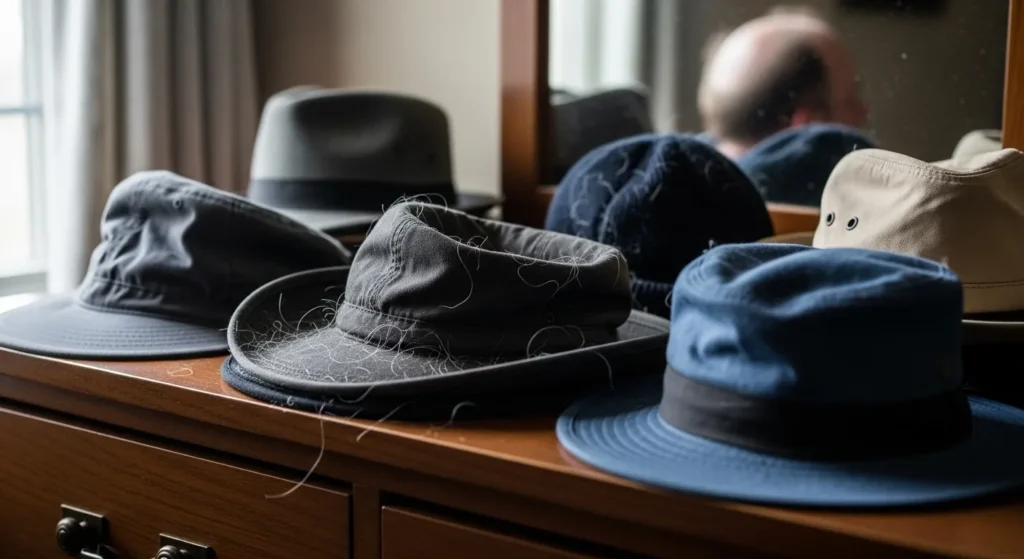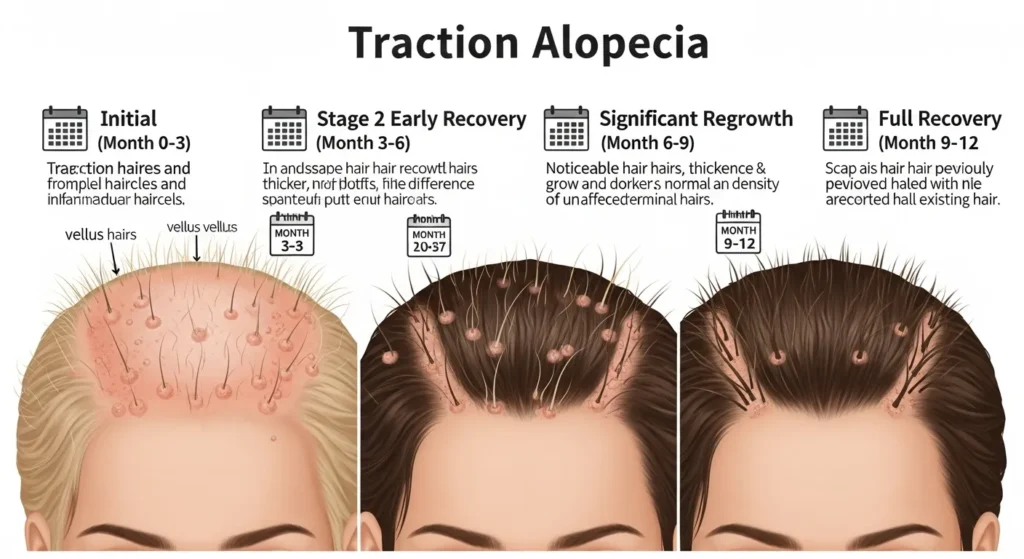Worried that hair loss from hats might be making your scalp thinner? You’re not alone—this is one of the most common grooming myths people search online.
In this guide, we’ll separate fact from fiction, explore the real causes (like traction alopecia), and share proven scalp-care tips.
Backed by medical insights and practical advice, you’ll learn how to keep your hair healthy without giving up your favorite cap, beanie, or head covering.

What Does the Research Say? Myth Busting & Key Studies
Many believe hats “block scalp circulation” or “suffocate hair follicles.” Science says otherwise.
- No direct link: Studies show no evidence that wearing hats causes male pattern baldness or genetic hair loss.
- Twin studies: Research comparing identical twins found no increased hair loss in those who wore hats daily.
- Expert insight: According to dermatologists, hair loss is primarily driven by genetics, hormones, or health conditions not by hats.
Understanding Traction Alopecia & Other Mechanisms
While most hats are harmless, specific wearing habits can trigger localized hair damage.
What is Traction Alopecia?
A form of gradual hair loss caused by repeated pulling or tension on hair shafts. Common in:
- Tight braids or ponytails
- Sports helmets
- Hats with tight elastic or straps
How Tight Hats, Helmets, Pins, and Turbans Contribute
- Pressure points: Elastic bands or clips press on the same scalp area daily.
- Prolonged wear: Minimal breaks between uses increase strain.
- Sweat & friction: Humidity under headgear can weaken hair shafts.
Scalp Irritation: Friction, Heat & Blood Flow Myths
- Heat from hats can increase sweat and sebum, irritating sensitive scalps.
- However, blood flow restriction is a myth—hats do not cut off follicle circulation.
Scalp Infections: Folliculitis & Tinea Capitis from Dirty Hats
- Dirty or damp hats can harbor bacteria and fungi.
- Symptoms: redness, itching, pustules, scaling.
- Prevention: Wash hats weekly, dry thoroughly before use.
Broader Causes of Hair Loss (Setting Hats in Context)
Even if hats occasionally aggravate scalp conditions, they’re rarely the root cause.
Key contributors include:
Genetics & Hormones (DHT)
- Male/female pattern baldness is linked to androgen sensitivity.
- DHT shortens the hair growth cycle, causing gradual thinning.
Stress-Induced Shedding & Nutritional Deficiencies
- Telogen effluvium: stress pushes hair prematurely into the shedding phase.
- Lack of protein, iron, vitamin D, or zinc can worsen hair health.
Under-Addressed Factors: Climate, Hijab, and Sweat
- In hot, humid climates, prolonged covered scalp time can raise sweat & oil buildup.
- Not a cause of genetic loss—but may worsen scalp irritation if hygiene is poor.
Prevention Tips: How to Wear Hats Safely
Follow these steps to avoid any risk of traction or scalp irritation:
Choose Loose, Breathable Materials
- Opt for cotton, linen, or moisture-wicking fabrics.
- Avoid synthetic linings that trap heat.
Proper Fit & Style
- Two-finger rule: You should comfortably slide two fingers between your scalp and the hat band.
- Avoid overuse of tight elastic or metal pins.
Wash Hats Regularly & Rotate Usage
- Weekly cleaning removes sweat, oil, and microbes.
- Rotate between multiple hats to reduce constant pressure points.
Protective Practices
- Keep hair moisturized to reduce breakage from friction.
- Consider a silk or satin scarf under helmets for reduced tension.
- Let scalp breathe for several hours daily.
Recovery Timeline (Traction Alopecia)
- Weeks 1-2: Remove cause (loosen fit, rotate hats)
- Weeks 4-8: Reduction in scalp irritation, possible baby hair regrowth
- 3-6 months: Significant thickening if follicles remain active

FAQ – Your Questions About Hair Loss from Hats Answered
Can wearing a hat make me go bald?
No, unless it’s excessively tight and worn daily for long periods, causing traction alopecia.
Are dirty hats making me lose hair?
Not directly, but they can cause scalp infections that temporarily affect hair health.
What hat styles are safest?
Loose-fitting caps, wide-brimmed hats, and soft-fabric beanies are low-risk.
When should I see a dermatologist?
If you notice redness, itching, or localized thinning that doesn’t improve in 3 months.
Get Pro Advice or Schedule a Consultation in Islamabad
If you’re experiencing hair thinning or scalp irritation, early intervention is key. Our team at Dr. Rana Irfan’s clinic in Islamabad offers expert diagnosis, traction alopecia treatments, and preventive scalp care advice.
Book your consultation today to protect your hair and restore your confidence.
Why You Can Rest Easy and Still Wear Your Favorite Hat
The idea of hair loss from hats is more myth than fact. While extremely tight or dirty hats can contribute to temporary problems, they aren’t a primary cause of permanent hair loss. By choosing the right materials, maintaining hygiene, and ensuring a comfortable fit, you can enjoy your headwear without risking your hair health.
